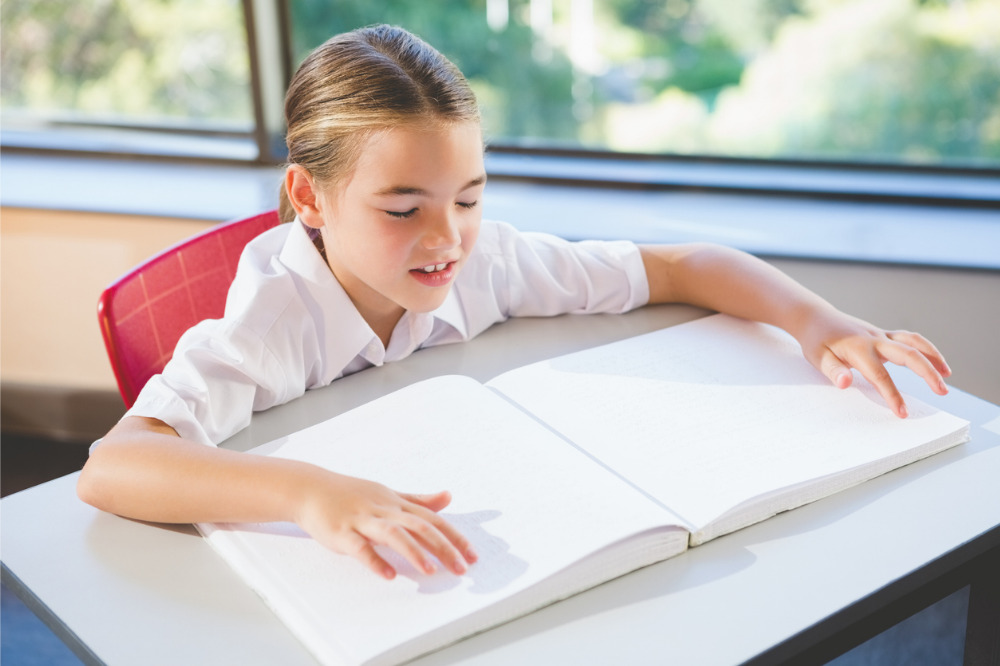
Whether an educator has been teaching for one year or twenty, the process of learning effective teaching practices that make a difference in the classroom is an ongoing one. After all, education research never sleeps.
For most teachers, engaging the different types of learners involves designing activities that address multiple modes of learning, such as visual, auditory, verbal, physical, logical, social and solitary.
However, teaching students who have visual impairments requires a very specific set of specialist skills, and these teachers must consider the amount of assumed visual content in their subjects when designing learning tasks.
One educator who knows this well is Wendy Murphy, an Itinerant Specialist Teacher (Vision) at Balgownie Public School, who works with the Illawarra Vision Team to plan personalised learning and support for vision impaired children.
In 2020, Murphy was named a finalist for the Teacher’s Mutual Bank Teacher of the Year Award at the Australian Education Awards in recognition of the outcomes she has been producing for students who not only have a vision impairment but may also have additional needs.
At that time, Murphy was a support teacher who worked with vision impaired children at Kingswood South Public School in Sydney. The students in Murphy’s class were given Individual Learning Plans, which required supporting and making modifications to the class learning program to ensure students had full access to the curriculum. From time to time, this also required one-to-one instruction in assistive technology, Braille literacy, fine and gross motor, social skills and orientation and mobility.
Reflecting on the disruptions brought about by Covid-19 Murphy said the initial stages were a very busy and challenging time both for her and her school community.
“We were required to adapt quickly to a new way of teaching and learning,” Murphy told The Educator.
“A fast and steep learning curve was needed to be able to model and present an accessible curriculum online and remotely in a personal and meaningful way for students with a vision impairment”.
Murphy said that while it was a difficult and challenging time that required additional workload commitment in hours for staff, it resulted in being a very rewarding experience.
“Our staff, students and families exceeded expectations. They were able to make the quick change from onsite learning at school to remote learning at home in Term 2, 2020, with the support of their families and regular ongoing communication with the classroom teacher, support teacher [vision], parents and students”.
Murphy said that with these supports and accessibility options students adapted very quickly to using a variety of online tools.
“Our students were also provided with weekly hardcopy resource packs, which were adapted to accommodate for their vision needs, e.g., large print, Braille and tactile resources were provided where needed to support their remote learning Program,” she explained.
“Some students were also provided with one-to-one lessons via video conferencing, following DOE guidelines to access Braille literacy, assistive technology lessons and the class learning programs. Students and staff have gained valuable new skills due to COVID-19 that they will be able adopt in the classroom and use when needed now and the future.”
Below, Murphy draws on her experience to share the practices that have helped her students thrive in the classroom.
Five effective and rewarding teaching practices
- Always remember why you chose teaching as a profession – Be passionate, love what you do, value your role as an educator, always remember as teachers we are privileged.
- Always have high realistic expectations and be specific about learning intentions to your students – Make sure it is clear to your student what they are learning about and what the goal is for the lesson.
- Value each student and their uniqueness – Be positive and find ways to modify and make each learning opportunity meaningful. Enjoy celebrating the little and big successes, share the joy you have in seeing them learn!
- Be organised, use variety of learning stimulus (auditory, visual and tactile) – Have learning routines, it can allow the student to feel confident in knowing what is coming next.
- Connect the curriculum to your students’ interests and life experiences – Create fun learning opportunities with real life experiences.


